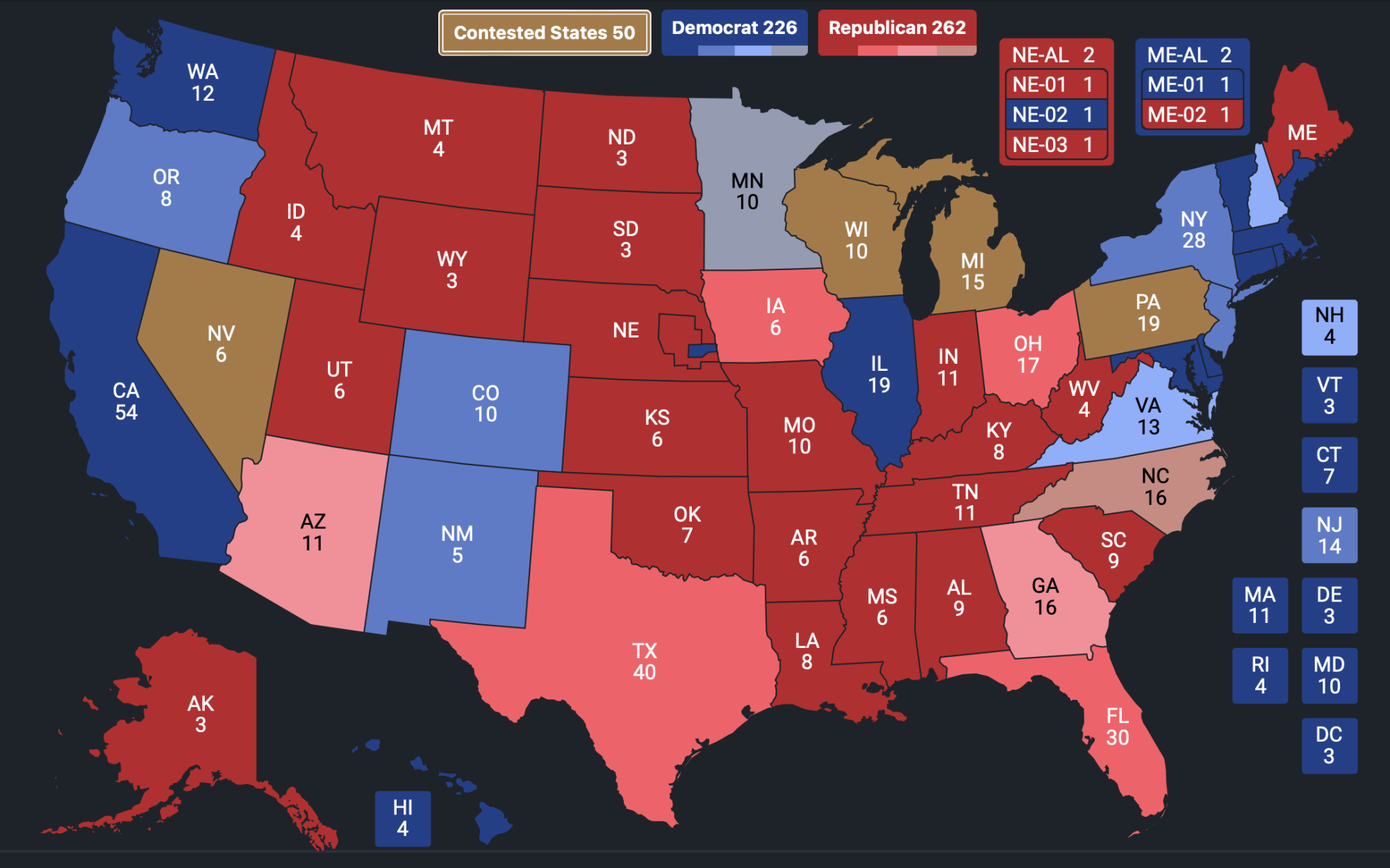
The entire country waits in anticipation for the upcoming elections on November 5, with the days counting down.
This year’s elections have been unusual, with the dropout of President Biden from the presidential race and multiple assassination attempts on former president Trump. Both the Democrat and Republican parties have been campaigning hard in swing states, especially Pennsylvania, Wisconsin, and Michigan, clearly displaying that these states are more important to the two parties versus any other.
The current polling data for this election is becoming increasingly unpredictable by day. ABC News’ FiveThirtyEight recently shifted its overall electoral prediction, which had favored Vice President Harris since her entry into the race, now showing Trump with a higher chance of winning this year’s election, estimating he would win 54 out of 100 simulations, while Harris would win 46 times out of 100.
Trump has a good chance in winning swing states Arizona, Georgia, and North Carolina, as the majority of pollsters, including The New York Times and RealClearPolling (RCP) show Trump leading in all three. This would put his electoral votes at 262. If Trump continues his slight lead of Pennsylvania into November 5, this would put him over 270 votes, giving the former President 281 Electoral Votes, securing his second presidency.
On the flip side, FiveThirtyEight shows that Vice President Harris holds a 54% chance of winning in Michigan, one of the more liberal leaning Rust-Belt states, while she holds a slight lead over Trump in Wisconsin, only at 51% chance of winning the state.Wisconsin has tended to be a more Red-leaning state in the Rust Belt for its more rural population and less college-educated voters in the state.
The Rust Belt swing-states have always tended to vote in one direction or another, all three always voting blue or red every election since the abysmal performance of Michael Dukakis for the Democratic Party in 1988.
Typically since then, Michigan, Pennsylvania, and Wisconsin have always voted democrat in almost every election since 1988, being known as the “Blue Wall” for this reason, except with Trump’s successful flip of the states in his victory in 2016. Today, this election looks tense: RealClearPolling presents the national votes polling as a tie between Former President Trump and Vice President Harris. RCP also has stated that Trump has the highest chance of winning in Pennsylvania, leading by 0.4 percent on average.
Polymarket, the world’s largest betting market, currently holds roughly $2.5 Billion dollars on the 2024 Presidential Race. After the dropout of Biden after the chaotic Presidential debate between him and Trump, Harris held a 54% chance of winning over Trump from around August into early October.
Recently though, betting odds are in favor of Trump, predicting he will win every swing state and holds a 67% chance of winning this election over Harris’ 36% chance.
Although an extremely large sum of money is circulating on the market, this election could really go either way. Both sides always show some sort of immediate bias on election predictions, depending on how popular support in a certain demographic is.
Polling data isn’t always the most accurate way of determining who will win certain states in Elections. For example, in 2020, RCP predicted Biden would’ve won Florida by 1.6, ultimately losing the state by nearly 3 points to Trump, displaying a frequent overestimation of candidates.
Generally, past polling data has shown overestimation for Democrats on average. This election really feels like the first one where the polling data seems at least more even to both sides. The majority of organizations, though greatly varied in results, have made their predictions clear.
Out of all states currently though, data averages from New York Times, RCP, and 538, combined with the betting odds of polymarkets prediction, Trump currently is on track to win Arizona, Georgia, North Carolina, and maybe even Nevada and Pennsylvania, which would put him over 270 electoral votes.
However, this election could really be in any candidate’s favor. Additionally, unlike previous elections like 2016, this election cycle will likely drag on for a few days, instead of releasing the results on the night of November 5.
If you really want to make an impact on this year’s election, get out and vote!






















































